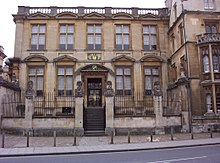F. Sherwood Taylor

Frank Sherwood Taylor (November 26 1897 – 5 January 1956) was a British historian of science, museum curator, and chemist who was Director of the Science Museum in London, England.[1]
F. Sherwood Taylor was educated at Sherborne School in Dorset, southern England and Lincoln College, Oxford.[2] He then undertook a PhD at University College, London in the new Department of History and Method of Science.
He spent a period as a schoolmaster and then as a lecturer in chemistry at Queen Mary College, London. He was a founder member of the Philosophy of Science Group. He was also the founder editor of the Ambix journal, started in 1937, and the journal of the Society for the History of Alchemy and Chemistry In 1940, he succeeded Robert Gunther as Curator of the Museum of the History of Science in Oxford.[3] Towards the end of his life, he was Director of the Science Museum from 1950 until his death in 1956. During this time, he delivered the 1952 Royal Institution Christmas Lectures in London on How Science has Grown. He was President of the British Society for the History of Science from 1951 to 1953.[4][5]
The Young Chemist and Sydney Brenner
In an interview conducted by Errol Friedberg, Sydney Brenner said:
I think like most children, I got interested in nature very early. And then by reading a little book called The Young Chemist by Sherwood Taylor, I got interested in actually doing chemical experiments. So I started my career as a garage chemist, buying chemicals from the local pharmacist and making things according to the prescriptions then, and going forward to more experiments, just on that basis. I then started — still while I was at school — extracting pigments from petals and just doing really cookbook chemistry, on that basis.[6]
Books
F. Sherwood Taylor wrote many books on the history of alchemy and chemistry in particular, and also of science in general:[7][8]
- Inorganic and Theoretical Chemistry (1931); 5th edition (1939)
- Organic Chemistry (1933)
- A Short Organic Chemistry (1933)
- The Young Chemist (1934, new edition 1961). Practical Books, Thomas Nelson and Sons, Edinburgh.
- The World of Science (1936);[9] 1064 pages
- Galileo and the Freedom of Thought (1938)[10]
- General Science for Schools: Parts 1–3 (1939)
- The March of Mind: A Short History of Science (1939)
- A Short History of Science and Scientific Thought, with readings from the great scientists from the Babylonians to Einstein (1940)
- The Century of Science (1941)
- The Conquest of Bacteria, from Salvarsan to Sulphapyridine (1942)
- Science, Past and Present (1945)[11]
- The Fourfold Vision: a study of the relations of science and religion (1946)[12]
- Two Ways of Life - Christian and Materialist (1947)
- A Century of British Chemistry (Science in Britain) (1947)
- Man's Conquest of Nature (1948)
- Concerning Science (1949)
- The Alchemists, Founders of Modern Chemistry (1949)[13]
- British Inventions (1950)
- Man and Matter - Essays Scientific & Christian (1951)
- The Alchemists (1952)
- Power Today and Tomorrow (1954)
- An Illustrated History of Science (1955)
- A History of Industrial Chemistry (Technology and Society) (1957)
- An Introduction To Alchemy
References
- ^ Ralph E. Oesper, "Frank Sherwood Taylor", Journal of Chemical Education, 27(5), p 253, May 1950. ACS Publications. doi:10.1021/ed027p253
- ^ A. C. C., Obituary: Frank Sherwood Taylor, The British Journal for the Philosophy of Science, Volume 7, Number 26, page 183–184, August 1956). Published by Oxford University Press on behalf of the British Society for the Philosophy of Science.
- ^ A. V. Simock (editor), Robert T. Gunther and the Old Ashmolean. Oxford: Museum of the History of Science, 1985. ISBN 0-903364-04-2. Page 93.
- ^ Taylor, F. S. (May 1954). "Reflections on the Writing of the History of Science". Bulletin of the British Society for the History of Science. 1 (10): 239–245. doi:10.1017/s0950563600000932.
- ^ Browne, Janet (1997). "Officers and council members of the British Society for the History of Science, 1947–97" (PDF). The British Journal for the History of Science. 30 (1): 77–89. doi:10.1017/s0007087496002919. S2CID 145396716.
- ^ "Genetic code, C. elegans, and recombinant DNA, 2000 Albert Lasker Special Achievement Award in Medical Science to Sydney Brenner". The Lasker Foundation.
- ^ F. Sherwood Taylor (1897–1956), LibraryThing.
- ^ Books › "F. Sherwood Taylor", Amazon.com.
- ^ "Review of The World of Science by F. Sherwood Taylor". Kirkus Reviews. 17 February 1937.
- ^ "Review of Galileo and the Freedom of Thought by F. Sherwood Taylor". Popular Astronomy. 47: 231. 1939. Bibcode:1939PA.....47..231T.
- ^ Glass, Bentley (June 1947). "Review of Science, Past and Present by F. Sherwood Taylor". The Quarterly Review of Biology. 22 (2): 143. doi:10.1086/395706.
- ^ MacCarthy, F. L. (1946). "Review of The Fourfold Vision by F. Sherwood Taylor". Religion and Science. Religion in Education. 13 (2): 59–60. doi:10.1080/4608556646; published by Taylor & Francis Online, 25 Feb. 2011
{{cite journal}}: CS1 maint: postscript (link) - ^ Grenell, R. G. (December 1953). "Review of The Alchemists: Founders of Modern Chemistry by F. Sherwood Taylor". The Quarterly Review of Biology. 28 (4): 405–406. doi:10.1086/399864.
